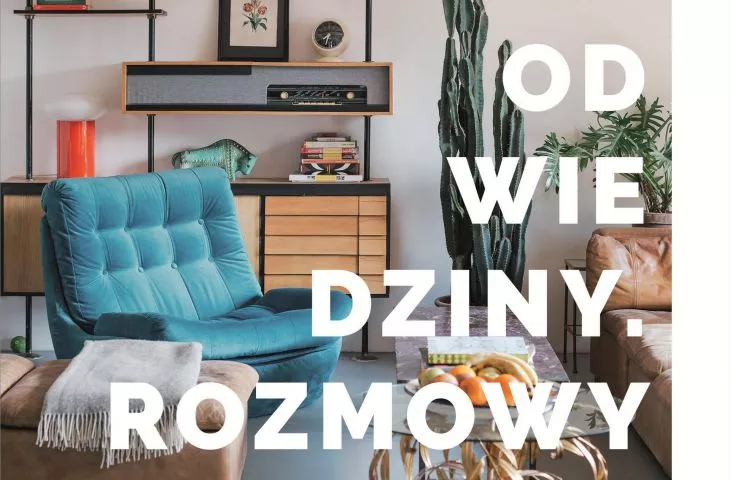If the author's name doesn't sound immediately familiar, the sound of her blog "Hygge" will change that. Aleksandra Koperda seeks out unusual places, people and spaces. Visit is not only the title of her book, but also a series on the blog. The author visits people in their homes. However, it's not just about interiors here - it's mostly about those who create them.
Aleksandra Koperda's interviewees include chefs, lovers of Polish post-war design, artists, restaurateurs, draftsmen, architects, designers and engineers with the soul of an artist. Each and every one of them tells the story of their apartment and the objects they surround themselves with, and reveals what inspires them. The author knocks us down to look through the keyhole into the interiors of ordinary-ordinary people.
In addition to the interviews, the book includes all sorts of advice - addresses of the best flea markets and antique stores, tips on how to buy your first painting, and short stories of design icons, such as the Panton chair.
Aleksandra Koperda is a cultural animator, fascinated by design, architecture and art for many years. Since 2016 she has been running Hygge Blog, where she talks about inspiring people - designers, designers, artists, craftsmen - and the interiors they live in. She lives in Krakow.
The first apartments in Superjednost were completed in 1968. The building was supported by reinforced concrete pillars, is almost 190 meters long and has 15 floors above ground, houses 762 residential units and 9 elevators that stand only on selected floors: 2, 5, 8, 11 and 14. There are three types of apartments throughout the block; what they have in common are balconies stretching the full width of the units and blind kitchens. In the original plans, the kitchens in the apartments were not to be there at all. On the top floor they wanted to create a cafeteria for all residents. Dominik's apartment, where he lives together with his dog Kuba, is 47 square meters. Dominik is an institution man known to many Katowice residents. A community activist, entertainer and urban partisan. He is the owner of the club cafe KATO - a place on Mariacka Street that initiated a lot of changes in this part of the city, co-founder of the store Geszeft - which promotes local design, an active activist in the My City Association, a fan of modernist architecture planting ivy in places that need it. His apartment, renovated ten years ago, is proof that a well-planned interior can be timeless. It's almost monochromatic.
A white hallway leads to an open space: a white living room with a white kitchen. There are no walls between the rooms, the bedroom was separated only by a white curtain. The use of white, optically enlarges the space. There is no unnecessary furniture, the important thing is the function. The white is contrasted with the juicy green of the magnificent
potted flowers.
Alexandra Koeprda: In 2009 you opened KATO , a bar that was no ordinary pub.
Dominik Tokarski: We organized debates, concerts, exhibitions, fairs. I wanted to create a community. Later, together with a friend, we opened a store called Geszeft. It started with an idea for a set of gadgets to promote Katowice, and that's how the first project was born - a mug with KATO written on it. Geszeft, like the KATO bar, was established in an establishment that no one wanted for a few years due to its uninteresting location. We took a risk, but it worked out.
Alexandra: Let's move on to the apartment. How did you end up here?
Dominik: I was looking for something on the top floor. After a few years of living under a rather noisy family, I knew I didn't want neighbors above me. I wanted to find something downtown so I could walk to work. The ad for this property was one of the first I came across. I made an appointment with the real estate agent, saw that it was on the fifteenth - top floor. I went out to the balcony, looked at Katowice and already knew that I would stay here. Although the interior did not look good at all! It needed a general renovation.
Aleksandra: What had to be done?
Dominik: The layout of the rooms was completely different than now - a blind kitchen, two rooms and a small cell. I gave up all the walls. Only the walls of the bathroom remained. An architect helped me with the design. According to the first plan, here, where the living room and kitchen are now, there was a bedroom, which did not work at all with my lifestyle. To get to the kitchen and dining area, one had to wade through the private area. The kitchen cabinets were stuck tantalizingly in place of the current closet. After some time, I decided to swap the function of the rooms. I wanted it to be like in old Silesian houses, where the first room had a kitchen with a stove, table and byfyj (Silesian sideboard), and it was there that guests were received, and in the second, private room, stood a bed. I had previously repainted the green walls white, and put pine boards on the floor. There was a bit of a problem with these planks, by the way, because at no angle did they go into the elevator. We carried them up the stairs here. This was quite a challenge. The planks were painted white with oil paint, the way floors in Silesian familias used to be painted.
"Visiting. Conversations about design" by Alekandra Koperda
Excerpt from the book courtesy of Znak Literanova Publishing House














